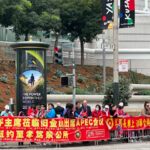A wide selection of Chinese defense products, including fighter jets and drones, are on offer to international customers at an ongoing aviation expo in the Middle East. Military experts expect Arab countries to show a strong interest in weapons and equipment from China amid restrictions from other suppliers.
The state-owned Aviation Industry Corporation of China (AVIC) has brought a full spectrum of Chinese aviation products, including fighters, helicopters, trainers, transport aircraft and drones, to the 18th Dubai Airshow, which is being held from Monday to Friday in the UAE, AVIC said in a press release on Tuesday.
At the indoor booth, AVIC is displaying advanced aviation equipment such as the FC-31 stealth fighter jet, the Y-20 strategic transport aircraft, the Z-20 tactical utility helicopter, as well as unmanned aerial vehicles, including the Wing Loong-X and the Wing Loong-2 fixed wing drones and the AR-36 vertical takeoff and landing drone.
In the center of the AVIC booth are full-scale models of the AR-2000 and AR-500W unmanned helicopters, with the AR-2000 being exhibited at an overseas expo for the first time, AVIC said.
With its rotor blades folded, the AR-2000 is equipped with an electro-optical pod under its nose, a maritime search radar under its chin, and three missiles under one side of its short horizontal wing, giving a strong indication that it was designed for shipborne operations, observers said.
Huang Guozhi, a Chinese military expert who visited the Dubai Airshow on Monday, told the Global Times that AVIC is the largest Chinese defense firm exhibiting at the Dubai Airshow and its products are very representative of the Chinese aviation industry.
The Y-20 model on display is an upgraded version that is equipped with large bypass ratio turbofan engines, while a model of the J-10CE fighter jet is also on display in tandem with flight performances by J-10C fighter jets from the Chinese People’s Liberation Army (PLA) Air Force Bayi Aerobatic Team, Huang said.
The flight performances will give potential customers in the Gulf region a better understanding on the capabilities of the J-10C, Huang said.
In the air, the Bayi Aerobatic Team’s J-10C fighter jets, the L-15 advanced trainer jet that has already won a purchase contract from the UAE, and the JF-17 fighter jet from the Pakistan Air Force delivered flight performances on the opening day of the airshow, marking the first time these three types of warplanes domestically developed by China have delivered simultaneous flight performances at an aviation expo abroad, AVIC said.
On the ground, an upgraded version of the L-15 painted with colors from the UAE national flag and possessing an active electronic scanning array (AESA) radar is on static display. Meanwhile, a Pakistan Air Force JF-17 Block 3, the latest version of the JF-17, is also on static display along with its airborne munitions.
Chinese defense products are an attractive option in the international market because they offer both high quality and high cost-efficiency, with no unreasonable political strings attached, Fu Qianshao, a Chinese military aviation expert, told the Global Times on Tuesday.
Middle Eastern countries are long customers of Chinese defense products like drones, and now they are looking at options for fighter jets, a market once dominated mainly by the US and Europe, Fu said.
But with the latest Palestine-Israel conflict among other geopolitical reasons, Arab countries can no longer acquire advanced fighter jets from the West, while the availability of Russian fighter jets is also in question due to the Russia-Ukraine conflict, analysts said, noting that this situation presents China with a good market opportunity as the country also has good relations with all the countries in the region.
Now that the UAE has purchased the L-15 advanced trainer jet, it is possible that Middle Eastern countries will consider the JF-17, the J-10C or even the FC-31, Fu said. “Having advanced technologies and sufficient production capacity, there are high hopes that China can become the main supplier of aviation equipment in the Middle East,” he said.
China’s arms exports are win-win cooperation that aims to provide other countries with means to carry out their independent defense policies and to safeguard regional peace and stability, unlike the US that ties arms exports with political strings to maintain its global military hegemony, experts said.
(Global Times)




